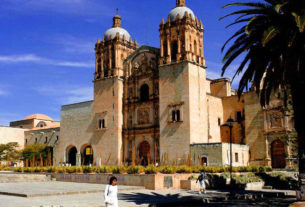Mexican Kitchen
June is a month of family celebrations; in México as well as north of the border, weddings, graduations and Father’s Day are all prominent June occasions. This month, I happily recall a couple of the many wedding fiestas, and their food, that our family has enjoyed during our years in Mexico. So, move over dads and grads, because here come the brides…
A Wedding in the Campo:
Turkey Mole and the Battle of the Bands
The bride was the daughter of our neighbor Lourdes and the groom was the son of a family who lived in the campo some miles out of town. We had been to other weddings here, but this was our first experience with compadrazgo, that formal tie that binds one family with another through help with life’s ritual events, from sponsorship at baptism to having the burial cross made. We had been asked by Lourdes and her husband to provide the brandy, several bottles of which would be on each table at the reception. Since the bride was one of sixteen children, we figured (correctly) that this would not be the last time we would be padrinos. And once this happened, as Lourdes reminded me solemnly, we would call each other comadre, and never by our first names again.
After the drive into the country, there was the wedding mass in the 16th century village church, with several other madrinas and padrinos participating. Those who bought the bouquets, rosary, coins, laso (a floral or ribbon rope which symbolically binds the couple) and other accoutrements of a traditional Mexican wedding are now all compadres of the couple and their families.
The religious part of the day over, it is time for the fiesta to begin in earnest. Long tables are set up under an awning outside the family’s huge, motel-like complex of a house. (Every time one of the sons marries, another room gets added on.) Guests find their way to tables and the toast is made. The first brandy is poured, and the soup is served. This particular soup is a sopa de milpa, a broth rich with vegetables: corn, squash and its blossoms, fava beans, nopales, strips of roasted poblano chile and fragrant epazote.
Next served is the rice course, with more fresh vegetables, this time carrots and tender, sweet peas. Then comes the main attraction, de rigueur at any central Mexican country wedding, mole de guajolote. These people evidently have several less turkeys than they did a few days ago, because we are told that they have killed their own birds to make the mole. Mountains of tortillas are eaten with this course, the better to sop up the rich, dark sauce. Our table is now well into its second bottle of brandy, and I glance around anxiously, hoping that we have supplied enough. One would not want to be a stingy comadre the first time at bat.
The party is now in full swing, with the band starting to play some tropical dance music. Huge, eardrum-blasting speakers have been set up, and everyone, from tiny tots to abuelitas, dances what seems to be a very long set. Just as we are eagerly anticipating a break, we are told that there will be no break because both the bride’s and the groom’s families have provided bands made up of their brothers.
Sometime during the evening, the bands stop long enough for the elaborate, many-tiered wedding cake to be sliced and served. A few words are said by the padrino of the cake, but nobody seems to be paying much attention. They are waiting for the dancing to begin again. And so it does, with the family bands alternating, each set getting louder than the previous.
We are about to collapse when our eyes are drawn to the sight of a most unusual dancer, not human at all, but a live turkey, one who has escaped the mole pot to be the guest of honor. Men are passing it carefully to one another, each one taking a few gentle steps with it. Someone offers it to my husband and he breaks into an oddly tropical version of a Texas two-step. The turkey is quickly hustled away from him and into the arms of the next dancer, for it is important that it live to enjoy the music – tomorrow it will be killed for the new couples’ first mole.
A Catered Affair at the “Cholula Hilton”
There is, of course, no Hilton hotel in Cholula, but there is a salon de eventos upon which we bestowed that nickname. With its gilded cherubs and faux Italianate fountain, it looks more like something out of a Trump hotel. The comadre is thrilled that one of her daughters is to have her reception catered here.
The doorbell had rung one afternoon several weeks beforehand. Well, well, if it wasn’t the comadre, with the latest novia in tow. This one had been a student of mine at the university and the groom was a Mexicana pilot, so this wedding would be a bit different from the one in the campo.
This time we are asked to be padrinos del brindis, providing the sidral, the sparkling, mildly alcoholic apple cider used for the toast. “My husband will not be here; he’ll be on a camping trip with his brothers in northern Mexico.” A look of mild panic crosses the comadre’s face. “But compadrito,” she says coaxingly, “my sons will play for nothing at your daughter’s wedding.”
The compadre agrees to buy the sidral, and leaves on his trip a few weeks later, after putting me in charge of ordering and getting it delivered.
This time the mass is in Cholula’s beautiful Convento de San Gabriel, and the reception hall is only a few blocks away. This is certainly no place for mole de guajolote or dancing turkeys. A look at the menu reveals a typical catered wedding meal, which could be good or not, depending upon the caterer: a cream soup followed by a pasta dish, (considered somehow more upscale than rice) and roast loin of pork. The sidral has been delivered and waiters are pouring it into champagne glasses, ready to toast the bride and groom.
There is a stirring in the hall, as people strain to hear what is being said over the loudspeaker. The comadre taps me on the shoulder, just as my daughter says, “I think it’s your name, Mom. He’s paging you.”
The comadre asks me if I am ready. Ready for what? The toast, she reminds me. The padrino of the brindis always makes the toast. “But since the compadrito is not here,” she says sweetly, “it falls to you to give the toast, comadre.” At this moment, I could cheerfully kill the compadrito. I did not think of this, have nothing prepared, and there are close to four hundred pairs of eyes beginning to look at me expectantly.
I turn toward my daughter, but she and her boyfriend just grin. “Oh, go ahead, Mom. You can do it. Just make something up.” With that less-than-inspiring advice, I make my way toward the head table, take a deep breath, raise my glass and offer what turns out to be a brief toast, heartfelt but none too original.
The rest of the evening is fine, the meal delicious. The cream soup is crema de nuez, a rich cream of walnut soup. The loin of pork is moist, stuffed with the fruit and almond filling reserved for special occasions. The compadrito is missing a great meal.
Recipes from Some Big, Fat Mexican Weddings
- Sopa de Milpa: Harvest Vegetable Soup
- Crema de Nuez: Cream of Walnut Soup
- Arroz Blanco con Verduras: White Rice with Vegetables
- Lomo de Puerco Relleno: Stuffed Roast Loin of Pork


